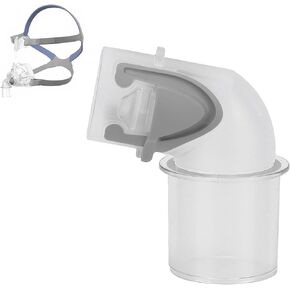- Shopping, made easy.
- /
- Get the app!
Reduced Skin Irritation:
Prolonged use of CPAP silk strap covers can lead to skin irritation due to continuous contact and friction. Pad a cheek CPAP straps for mask act as a barrier, preventing direct contact and reducing the risk of irritation, redness, or pressure marks
Cushioning Effect:
The covers as a CPAP skin protector provide a cushioning effect between the CPAP headgear and the skin. By acting as a barrier between the CPAP mask cushion and the user's skin, they distribute pressure more evenly, which can help in preventing pressure sores and enhancing overall comfort.
Package Contain:
You will receive 6 pieces of CPAP face protector for CPAP supplies. Sufficient quantity can meet your use and replacement.These covers are compatible with a wide range of CPAP masks, including nasal, full face CPAP mask, and nasal pillow styles, ensuring a broad applicability for various users. Pairing with a CPAP neck pad will also give better results
Comfort Enhancement:
The surface of the CPAP strap comfort pads for face mask is made of satin, and the interior is filled with cotton material. Users are more likely to adhere to their therapy if they find it comfortable, leading to improved overall treatment effectiveness. Moreover, these CPAP pads strap covers are designed with the user's ease in mind, featuring materials that are not only comfortable but also easy to clean, ensuring that maintaining hygiene doesn't become a cumbersome task.
Keep the Mask in Place:
The CPAP mask cushions are designed to enhance the comfort and usability of CPAP therapy for individuals with sleep apnea.Installation is a breeze, thanks to their design that allows them to be easily wrapped around the CPAP mask straps and securely fastened with hook-and-loop closures. This feature not only simplifies the setup process but also ensures the covers stay in place throughout the night, preventing any disruptions to sleep.
In summary, CPAP mask cover as a practical solution to enhance the overall comfort of CPAP therapy by reducing irritation, providing cushioning, preventing pressure sores, and minimizing the risk of adverse reactions to mask materials
 6 Pairs Soft Nasal Oxygen Covers Oxygen Tubing Protectors Nasal Cover Nasal Strap Comfort Pads Oxygen Strap Cushions for Oxygen Users to Full Protect Your Face Sleep Tube Supplies(Blue)
KWD 3
6 Pairs Soft Nasal Oxygen Covers Oxygen Tubing Protectors Nasal Cover Nasal Strap Comfort Pads Oxygen Strap Cushions for Oxygen Users to Full Protect Your Face Sleep Tube Supplies(Blue)
KWD 3
 1-Pack Westmed #0106 Pediflo Nasal Mask with 7' Kink Resistant Tubing
KWD 2.500
1-Pack Westmed #0106 Pediflo Nasal Mask with 7' Kink Resistant Tubing
KWD 2.500
 Metal Oxygen CGA-540 Cylinder Wrench by Responsive Respiratory
KWD 6.500
Metal Oxygen CGA-540 Cylinder Wrench by Responsive Respiratory
KWD 6.500
 Replacement Elbow Connector for Mirage FX, Replacement Elbow Connector Assembly Accessory Fit for Mirage FX Nasal
KWD 3.500
Replacement Elbow Connector for Mirage FX, Replacement Elbow Connector Assembly Accessory Fit for Mirage FX Nasal
KWD 3.500